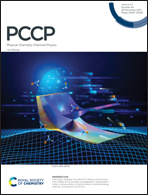Molecular insights into the urea–choline-O-sulfate interactions in aqueous solution†
Abstract
Urea and choline-O-sulfate (COS) are both osmolytes, but have opposite effects on protein structure. Urea has been well-known for years to destabilize protein structure. Though COS has been revealed as an osmoprotective molecule against urea induced denaturation of proteins, the mechanism of this compensation is still unexplored. This study focuses on a theoretical investigation of the interdependent behavior of urea and COS in a mixture, to explore how urea becomes a weaker denaturing agent in the presence of COS. In this study, we have considered every possible interaction among the solute (urea and COS) and solvent (water) both at room temperature and high temperature, employing two different force field parameters i.e., CHARMM General Force Field parameters (CGenFF) and General AMBER Force Field (GAFF) parameters through classical molecular dynamics simulation studies. Different techniques have been used to analyze the average interactions between COS and urea as well as their solvation properties, which show that in the presence of COS, urea becomes a less effective denaturant than when alone. The water–water interaction shows that the mixed osmolyte solution of urea and COS strengthens the water hydrogen bonding network. The enhanced solvation of urea and COS in the urea–COS mixture and their mutual interactions, results in the exclusion of free urea as well as COS from the solution. This synergistic behavior of urea and COS could be the major reason behind COS counteracting urea’s denaturation of proteins.



 Please wait while we load your content...
Please wait while we load your content...